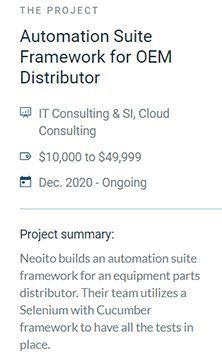Every software should be tested before it is released to the users as it helps to ensure the software’s quality.
For testing practices, most of the companies are tending towards manual or automation testing.
In manual testing, tests are executed by a QA analyst. And if any bugs are found, the testing team reports to the developers to fix the bugs. This process continues until the product is bugs-free.
While in automated testing, testers write test scripts/code to automate test execution. They use automation tools to develop test scripts and validate the software. The goal is to complete test execution in less time.
Manual testing is time-consuming, so enterprises are looking for faster and efficient software testing practices for faster releases of quality products. This is where the test automation framework appears.
What is the Automation Framework?
Automation Framework is not a single tool or process. It is a customised collection of processes and tools that work harmoniously together to help automate the testing of any application. Think of it this way, it has specific features like libraries, reusable modules, and test data.
It helps enterprises to standardise all their test automation assets, regardless of the tools they are using.
Why do you need a Test Automation Framework?
Test Automation Framework is used in situations where multiple test cycles must be conducted for a large number of test cases.
-
-
- It helps increase the team’s efficiency and speed, also it reduces test maintenance costs and improves test accuracy.
- It makes your processes and applications easier to test, more readable, scalable, maintainable, and reusable.
-
Test automation frameworks are used to run commands and scripts many times with various builds to verify the output and test applications.
It takes time to develop an automation framework. So, it is advised not to automate functionalities that are used only once. More than that, automation takes a lot of time, effort, and resources. Therefore, it should be used for functionalities that are used multiple times.
So, here the question is:
If the automation frameworks are so time and resource-consuming, why can’t a simple script work?
And the answer:
Scripts are not appropriate for test cases where you are testing many scenarios. When you create test scripts for every scenario, your application test suite will become too big.
It means if any tweaking in the property or application of any of the objects needed, you need to alter all the scripts, and that is heavy. To avoid that, you can use test automation frameworks.
So, for an efficient test automation process, test automation frameworks are vital.
Types of Test Automation Frameworks
Each automation framework has its own architecture, advantages and disadvantages. Below given are the different types of automation frameworks.
Behaviour-Driven Framework (BDD)
A behaviour-driven development framework is used to create a platform that allows every Testers, Developers, Business analyst, etc. to engage actively. In addition, it helps to increase collaboration between the tester and the developers in your project.
-
-
- Pros: It doesn’t require the users to be familiar with a programming language. With non-technical, natural language, test specifications can be created.
- Cons: To work with BDD, sufficient technical skills and prior experience in Test Driven Development (an iterative approach which is a combination of programming, creation of unit tests, and refactoring) is required.
-
In BDD, good communication is crucial between the people who write the feature files and develops the automation code. The coder should interpret these files and the scenarios to implement them as automation steps. If there is no mutual understanding about the structure and the approach being used, the scenarios become increasingly difficult to turn into working automated tests. This can lead to problems.
Another issue is Data-driven testing, the BDD’s support for defining test data makes it easier to create data-driven automated test scenarios. But, issues arise when trying to execute these tests in test environments that are never left in a known state. Also, with the execution of the automated tests, dependencies on external data feeds can often cause issues.
Modular-Driven Framework
In this, the testers create individual test scripts by dividing the application into multiple modules. These individual test scripts can be combined to make larger test scripts. It is done by using a master script to achieve the needed scenarios.
This master script is used to invoke the individual modules to run end-to-end test scenarios. This framework builds an abstraction layer to protect the master module from any alterations made in individual tests.
-
-
- Pros: Modular-driven frameworks make sure that the division of scripts leads to easier maintenance and scalability. Thus the testers can write independent test scripts. Also, the changes made in one module bring no or low impact to the other modules.
- Cons: Modular-driven frameworks take more time to examine the test cases and to identify reusable flows. It requires coding skills to set up the framework.
-
Library Architecture Testing Framework
Library Architecture Testing Framework is also known as “Structured Scripting” or “Functional Decomposition.” It is based on modular framework with some additional benefits.
In modular-driven framework, testers can divide applications under test into modules, whereas in Library Architecture Testing Framework, they can identify the common tasks and group them into functions. After that, these groups will be kept in a library.
The test scripts reuse these libraries to create new test cases.
-
-
- Pros: This framework will lead to a high level of modularisation that makes test maintenance and scalability easier and more cost-effective.
It has a library of common functions that multiple test scripts can use. So, it has a higher degree of reusability. - Cons: In Library Architecture Testing Framework, it takes more time to develop test scripts. Also, to work with this framework, coding skills are required to write and analyse the common functions within the test scripts.
- Pros: This framework will lead to a high level of modularisation that makes test maintenance and scalability easier and more cost-effective.
-
Linear Automation Framework
The linear automation framework is commonly used to test small applications. It is also called a Record and playback framework. With this, testers don’t need to write code to make functions. And the steps are written in sequential order.
Here, the tester records each step, such as navigation, checkpoints, or user input, and then plays the script back automatically to conduct the test.
-
-
- Pros: As you don’t have to write custom code, expertise in test automation is not necessary. The code can be easily recorded in a minimal amount of time, so it is one of the fastest ways to generate test scripts.
In this, the test scripts are laid out sequentially, so anyone involved in testing will find the test workflow easier. - Cons: The scripts developed using this framework are not reusable. The data is hardcoded into the test script. It means the test cases cannot be re-run with multiple sets. If the data is modified, test cases also should be changed.
- Pros: As you don’t have to write custom code, expertise in test automation is not necessary. The code can be easily recorded in a minimal amount of time, so it is one of the fastest ways to generate test scripts.
-
The maintenance is considered a hassle as any changes in the application need a lot of rework. And this model is not particularly scalable as the testing scope expands.
Data-Driven Framework
This model separates the test data from script logic. It means the testers can store data externally. Testers will frequently need to test the same feature or function of an application multiple times with various sets of data.
In these instances, the test data mustn’t be hard-coded in the script itself like a Linear or modular-driven framework.
Setting up a data-driven framework will let the tester store and pass the input/output parameters to test scripts from an external source. It can be Excel Files, Text Files, SQL Table, CSV Files, or ODBC repositories.
The test scripts are connected to the external data source, and when needed, they are told and populate the necessary data.
-
-
- Pros: As they reduce the number of scripts needed, multiple scenarios can be tested in less code.
Hard-coding data can be avoided so that changes made to the test scripts do not affect the data being used and vice versa. - Cons: You will need a well-versed tester who is proficient in various programming languages to completely utilise this framework’s design.
- Pros: As they reduce the number of scripts needed, multiple scenarios can be tested in less code.
-
Keyword-Driven Framework
Keyword-Driven Framework also known as table-driven testing, is suitable only for small projects or applications. The automation test scripts performed are based on the keywords stored in the excel sheet of the project.
These keywords are a part of a script representing the various actions performed to test the GUI of an application. These can be labeled simply as ‘click’, ‘login’, or with complex labels like ‘click link, or ‘verify link.’
-
-
- Pros: For this framework, minimal scripting knowledge is required. The code is reusable as a single keyword can be used across multiple test scripts.
- Cons: The initial setup cost of the framework is high. It is also time-consuming and complex. To work with this framework, you need an employee with good test automation skills.
-
Hybrid Testing Framework
A hybrid testing framework is a combination of Data-driven and Keyword-driven frameworks to execute the most out of the frameworks mentioned above. It is to leverage the benefits and strengths of other frameworks for the particular environment it manages.
-
-
- Pros: This model leverages the advantages of all kinds of related frameworks.
- Cons: In this model, tests are entirely scripted. Thus, it increases the automation effort.
-
Conclusion
We at NeoITO believe that turning your ideas into reality is important. We allow companies to grow their dreams into million-dollar businesses, and our test automation framework solutions do just that.
Located in Thiruvananthapuram, India, we have a proven track record in delivering groundbreaking technologies that launch businesses to success. We’re proud to share one of our client’s reviews about how we helped them on their recent test automation framework project.
Our latest review on Clutch, one of the leading B2B review and market resource platforms, features a test automation framework project. We got a five-star rating review, and we are genuinely thankful for our clients’ phenomenal words. Our team is tasked with helping our client rework their database and test their website.

“The quality of their work is definitely commendable — they always meet our expectations.”
You can check out our Clutch profile to read the full review.
In addition to our automation suite framework solutions, we are also known for our other services. Just recently, our team also ranked for our outstanding software solutions on The Manifest. Our team is excited to show more of what we can do. Whether it’s a software development project or a test automation framework, we got you covered!







